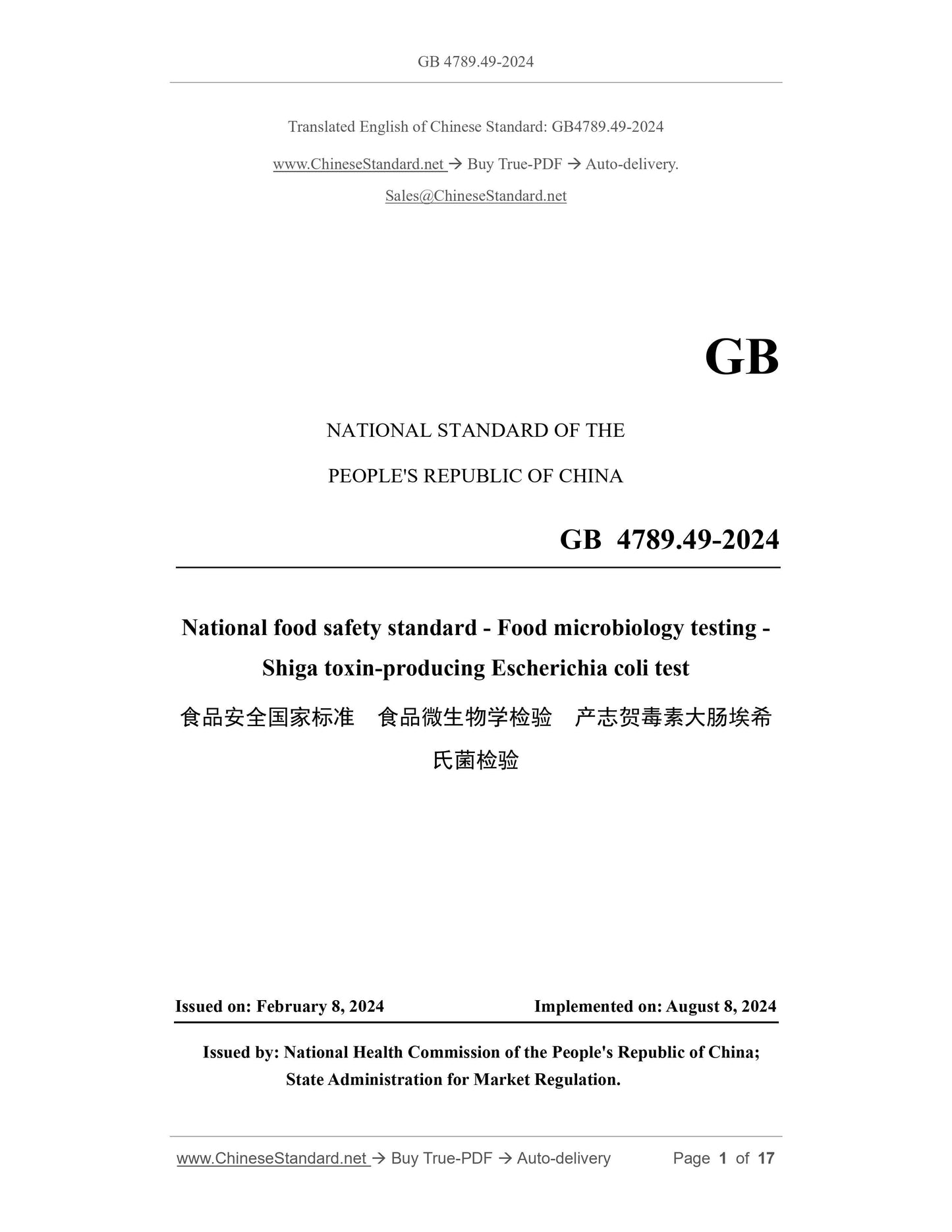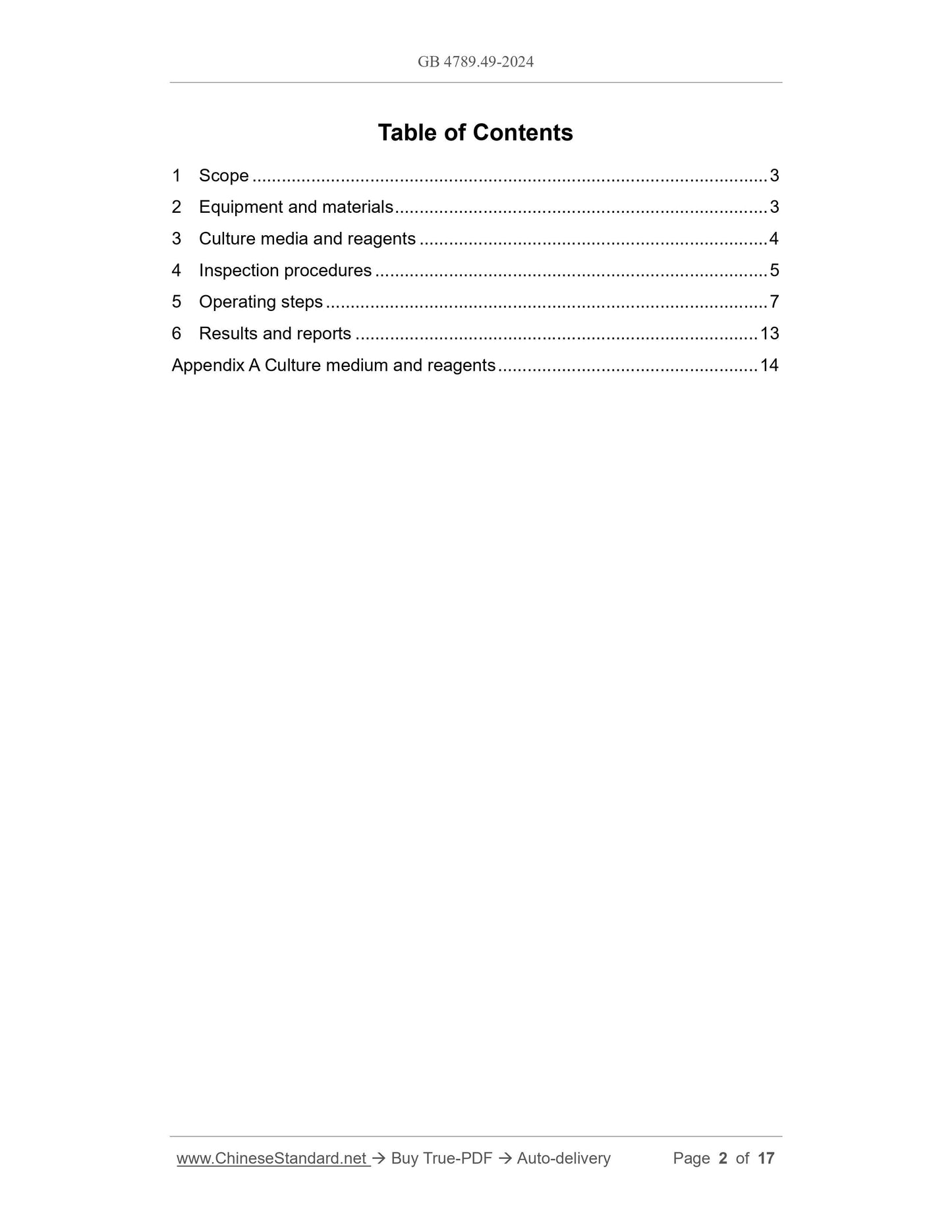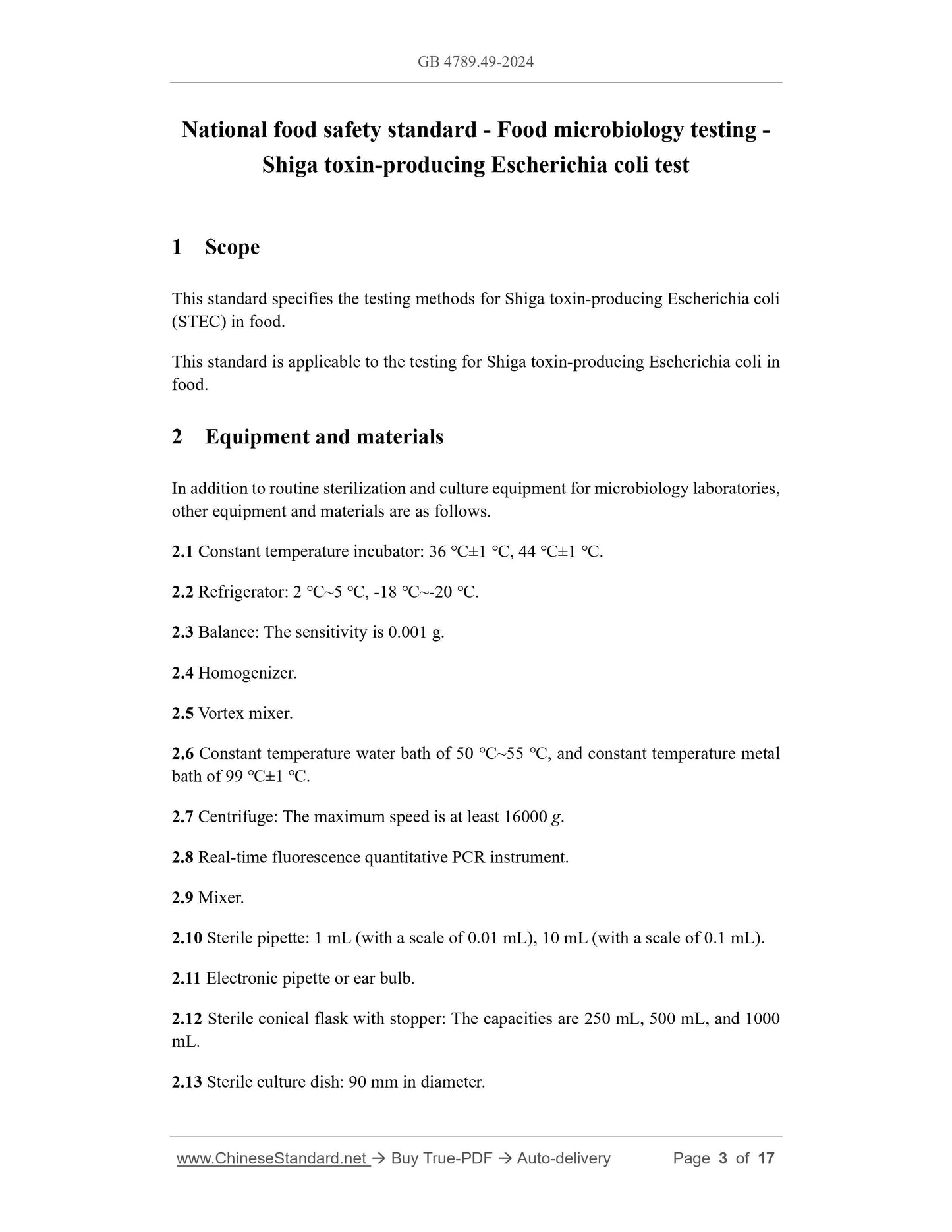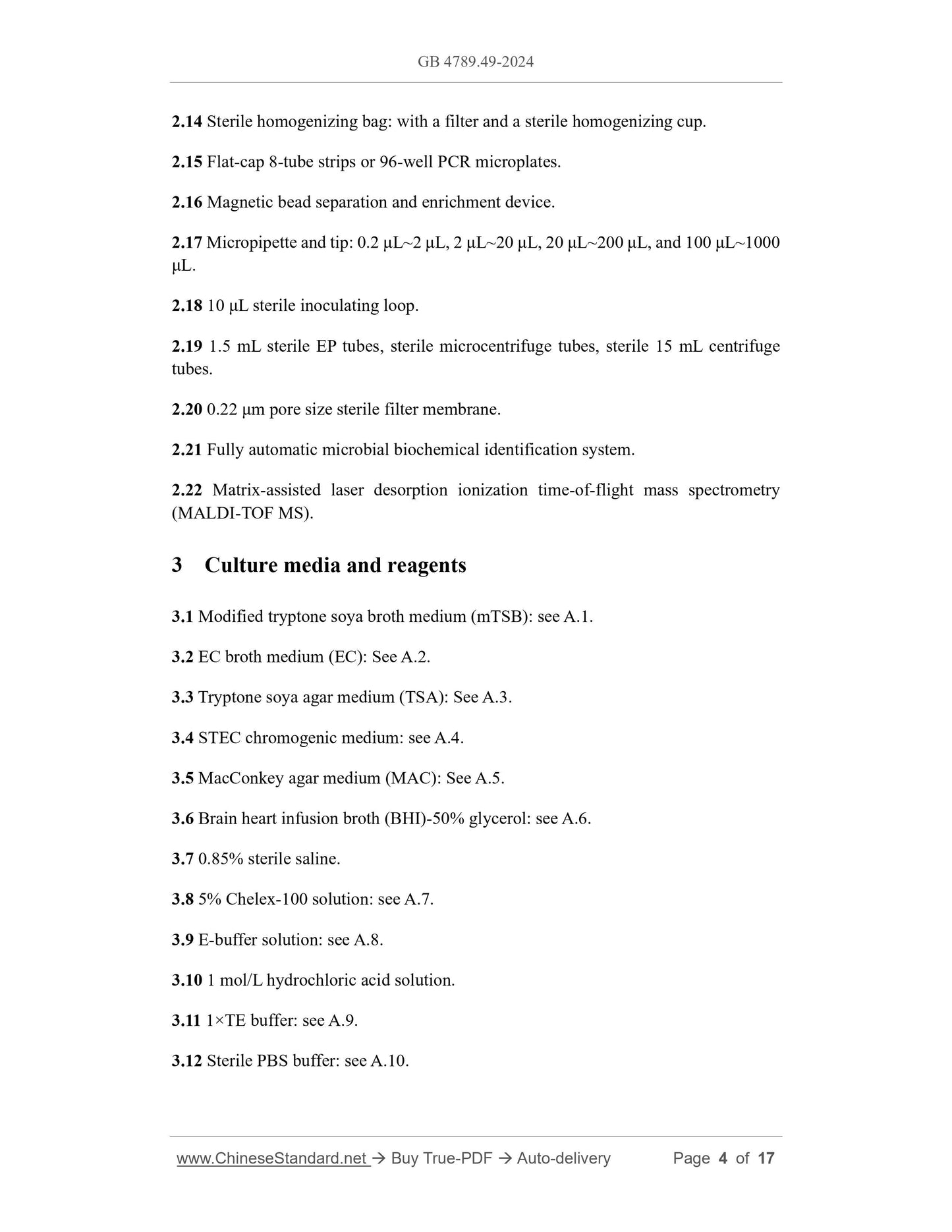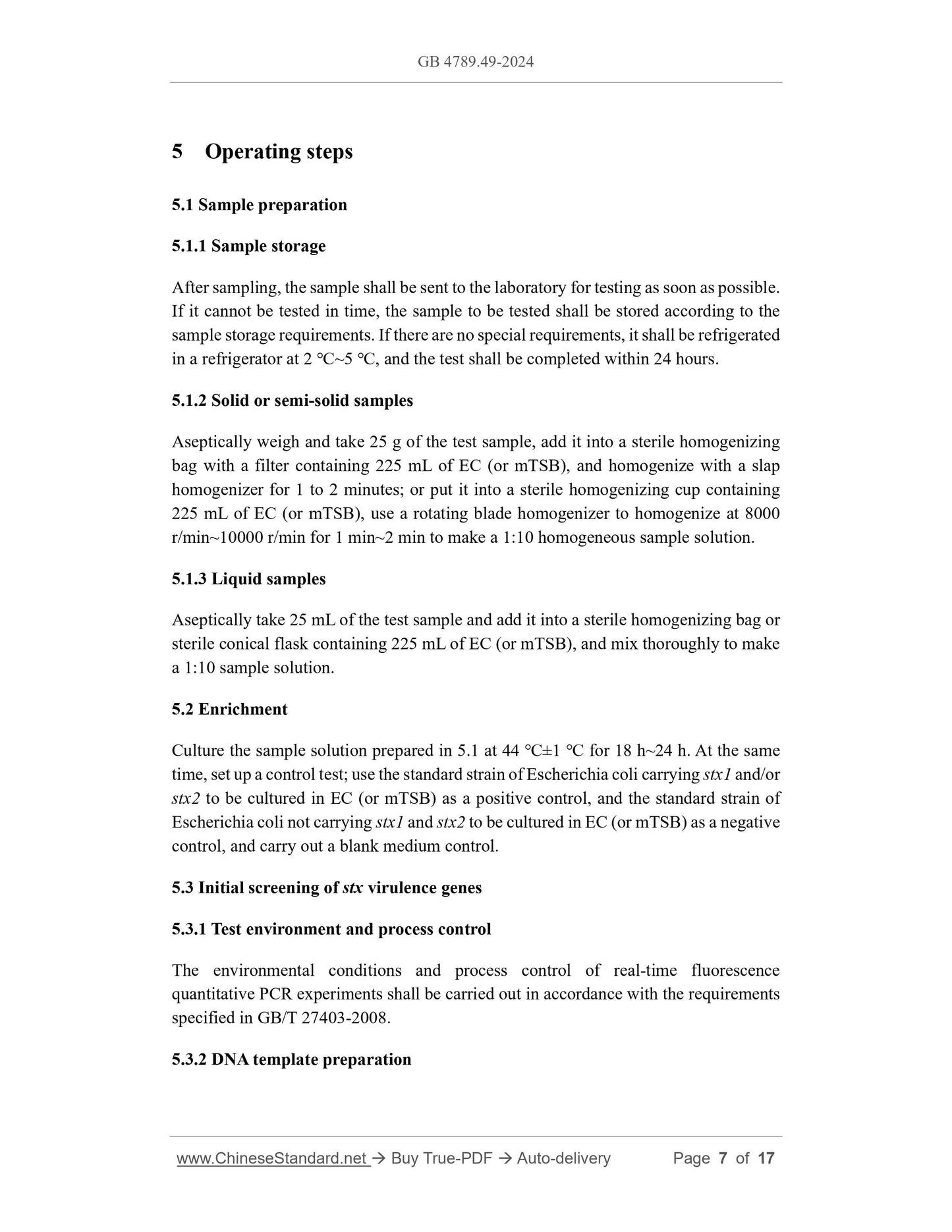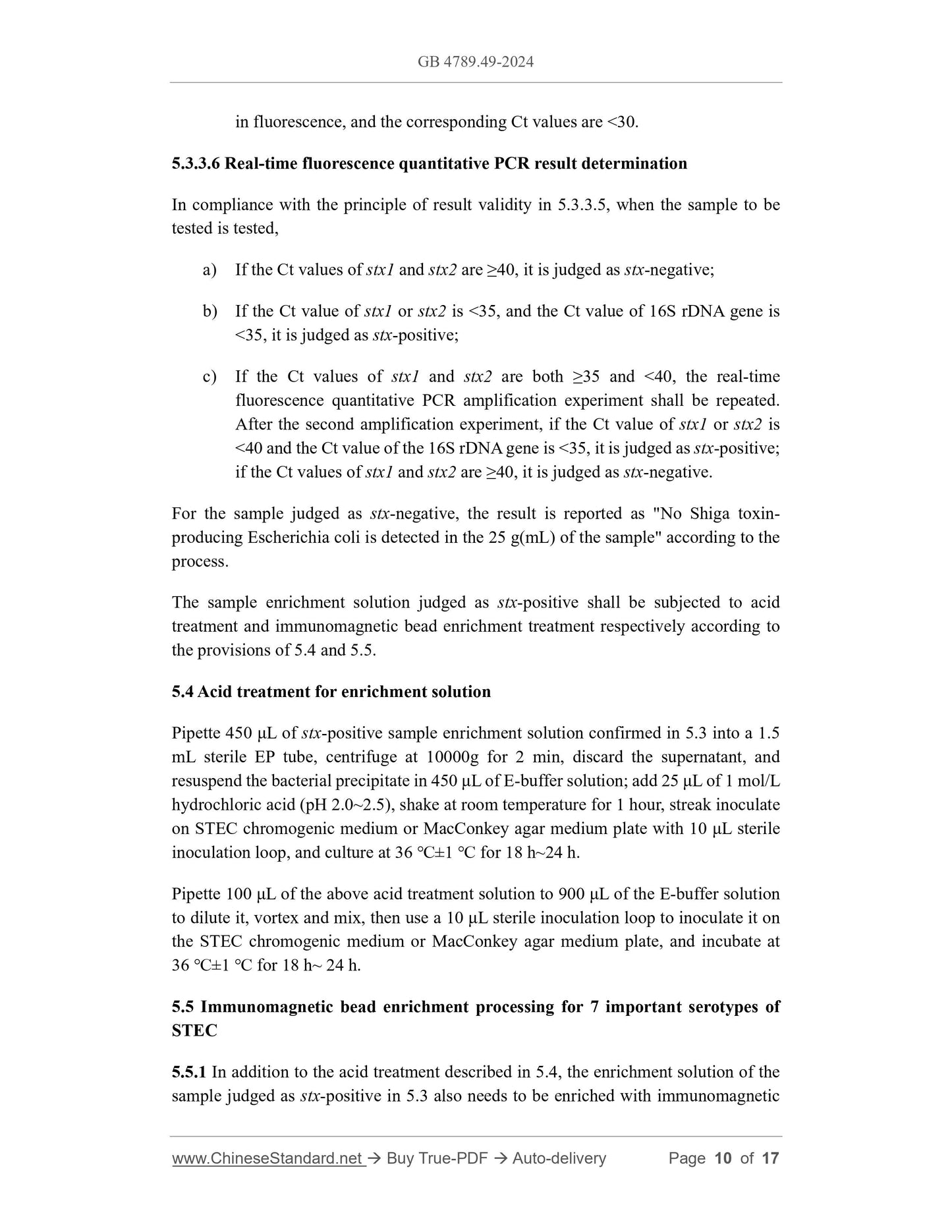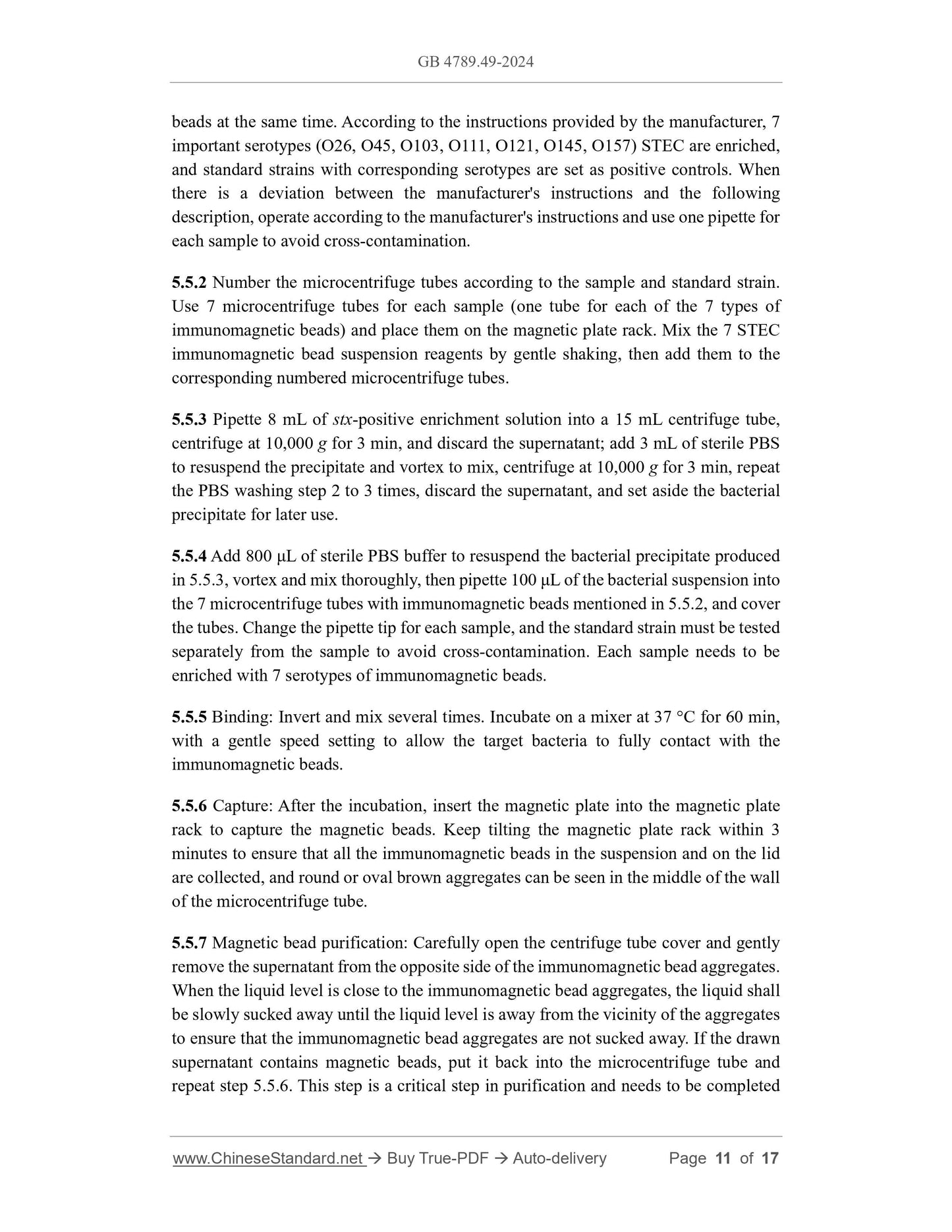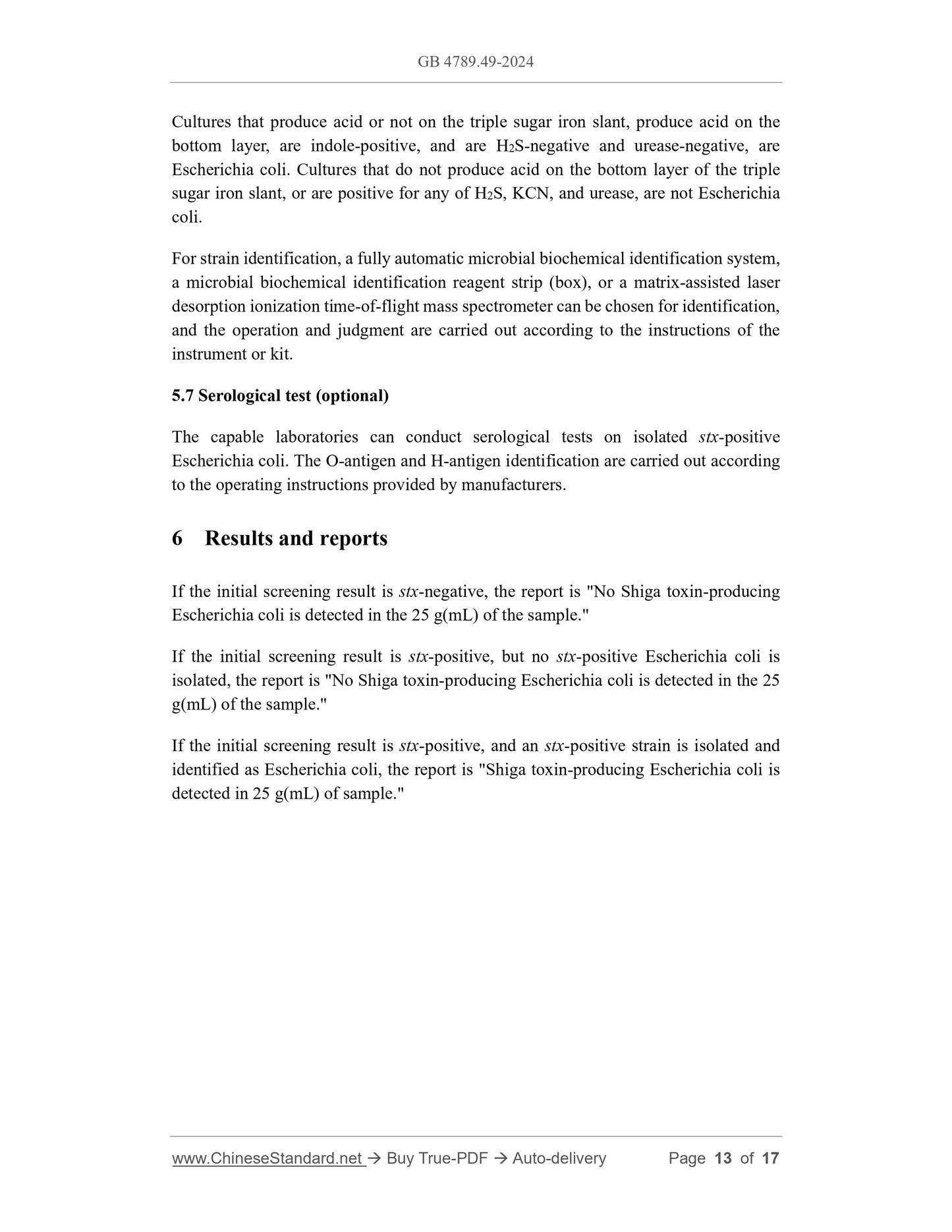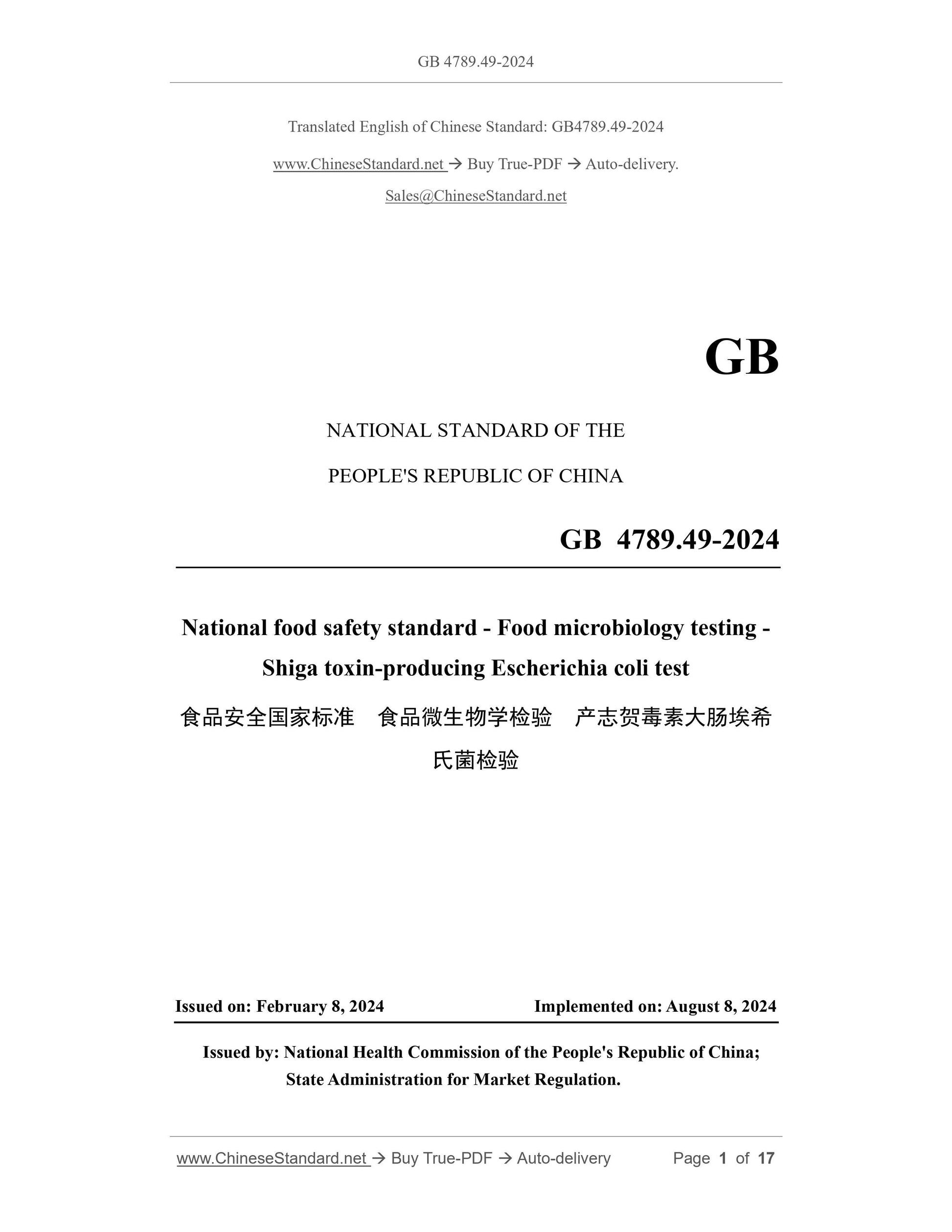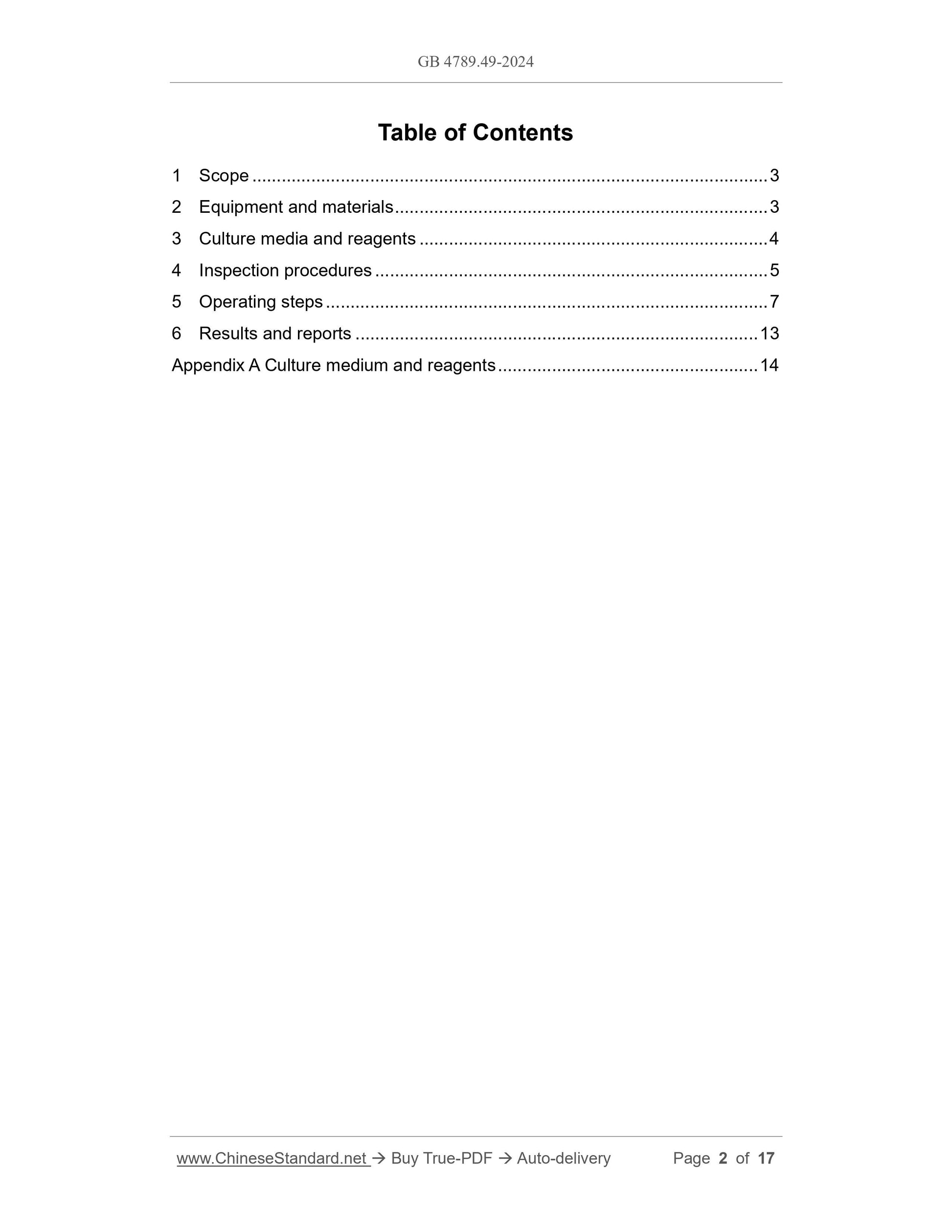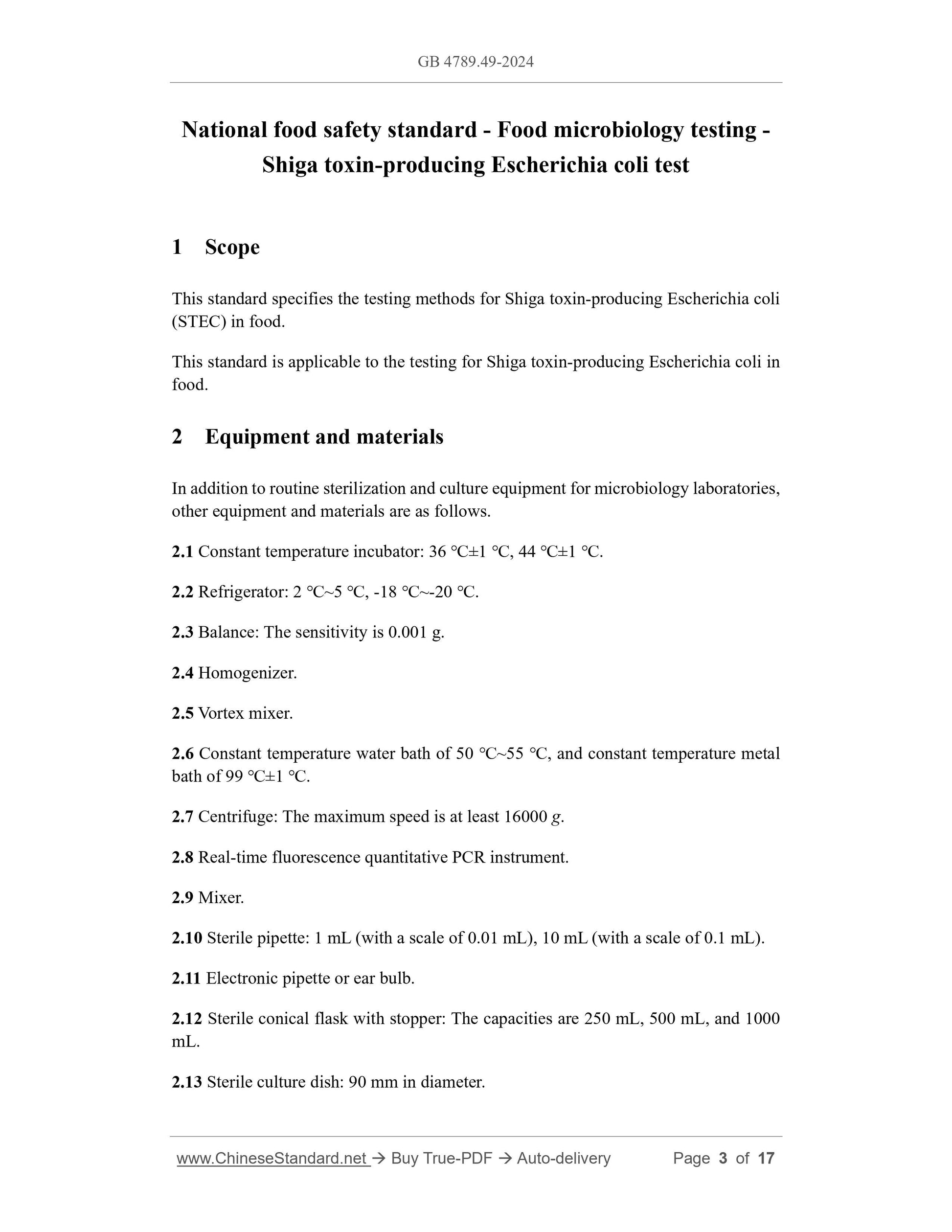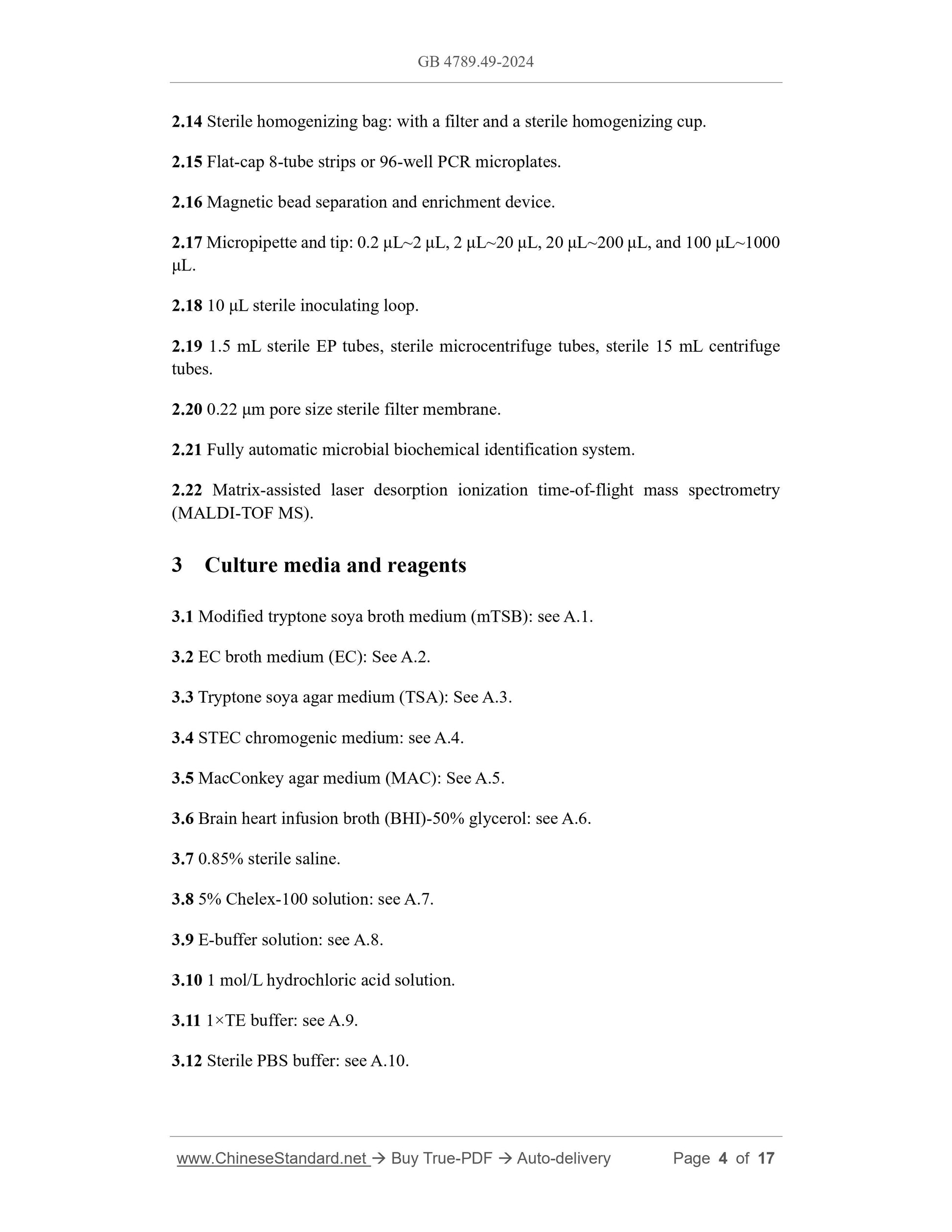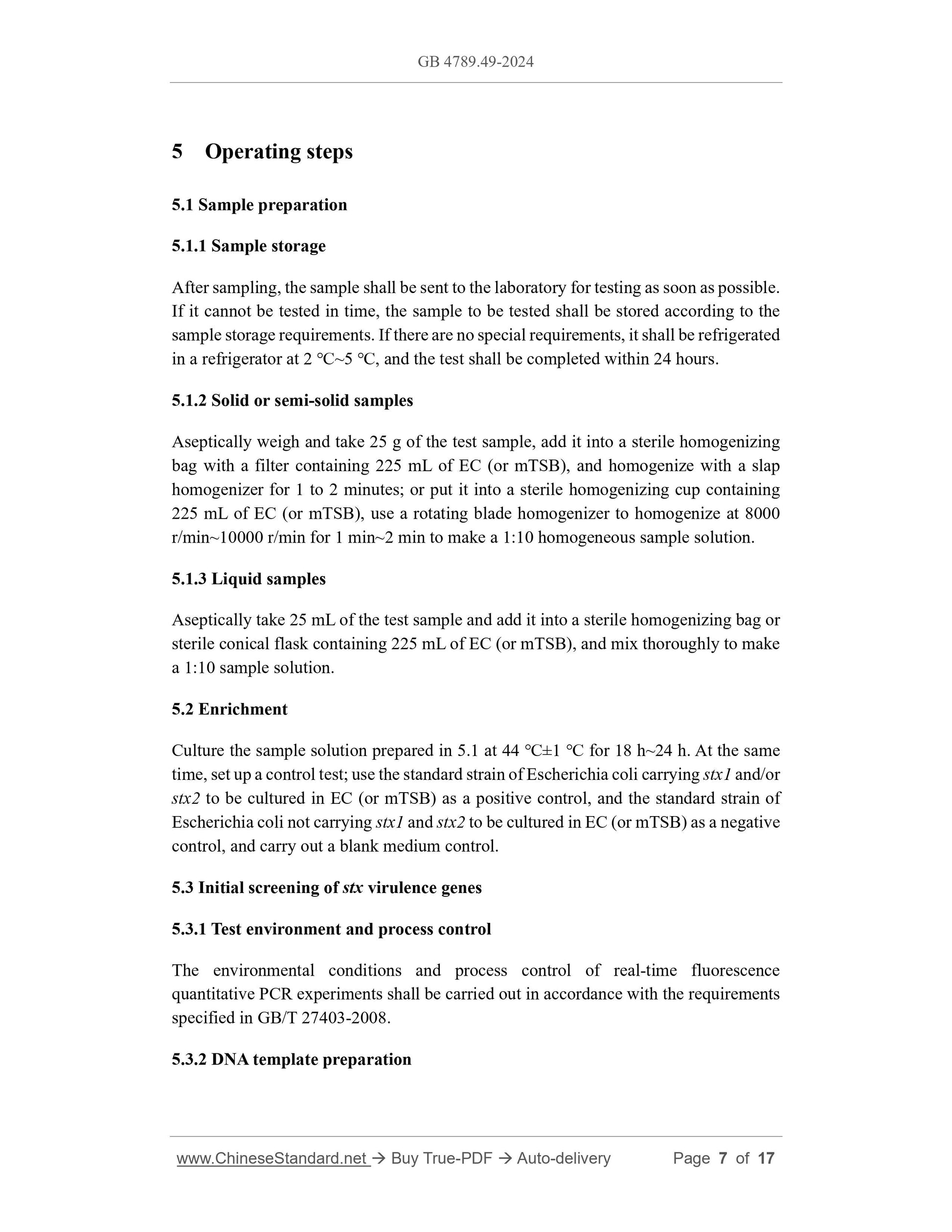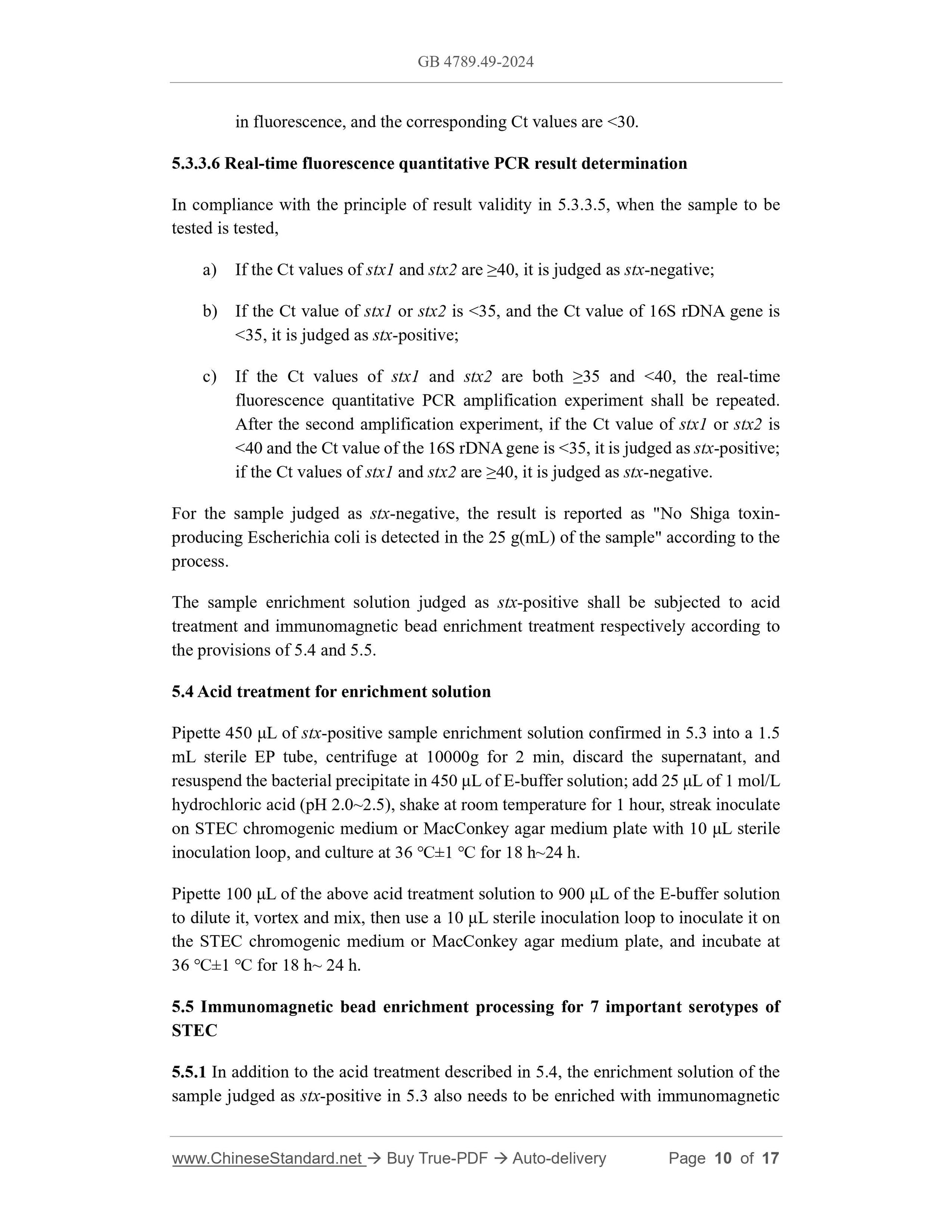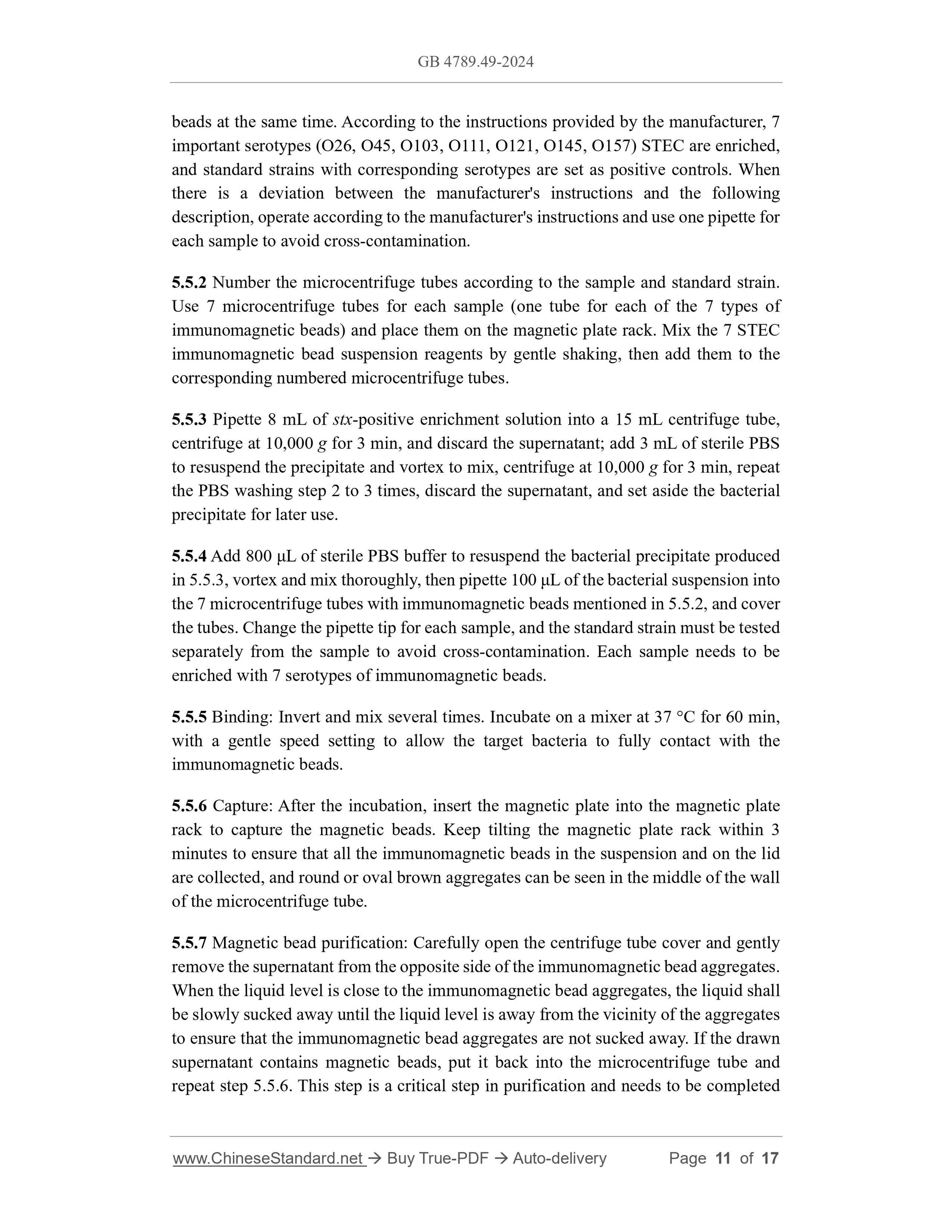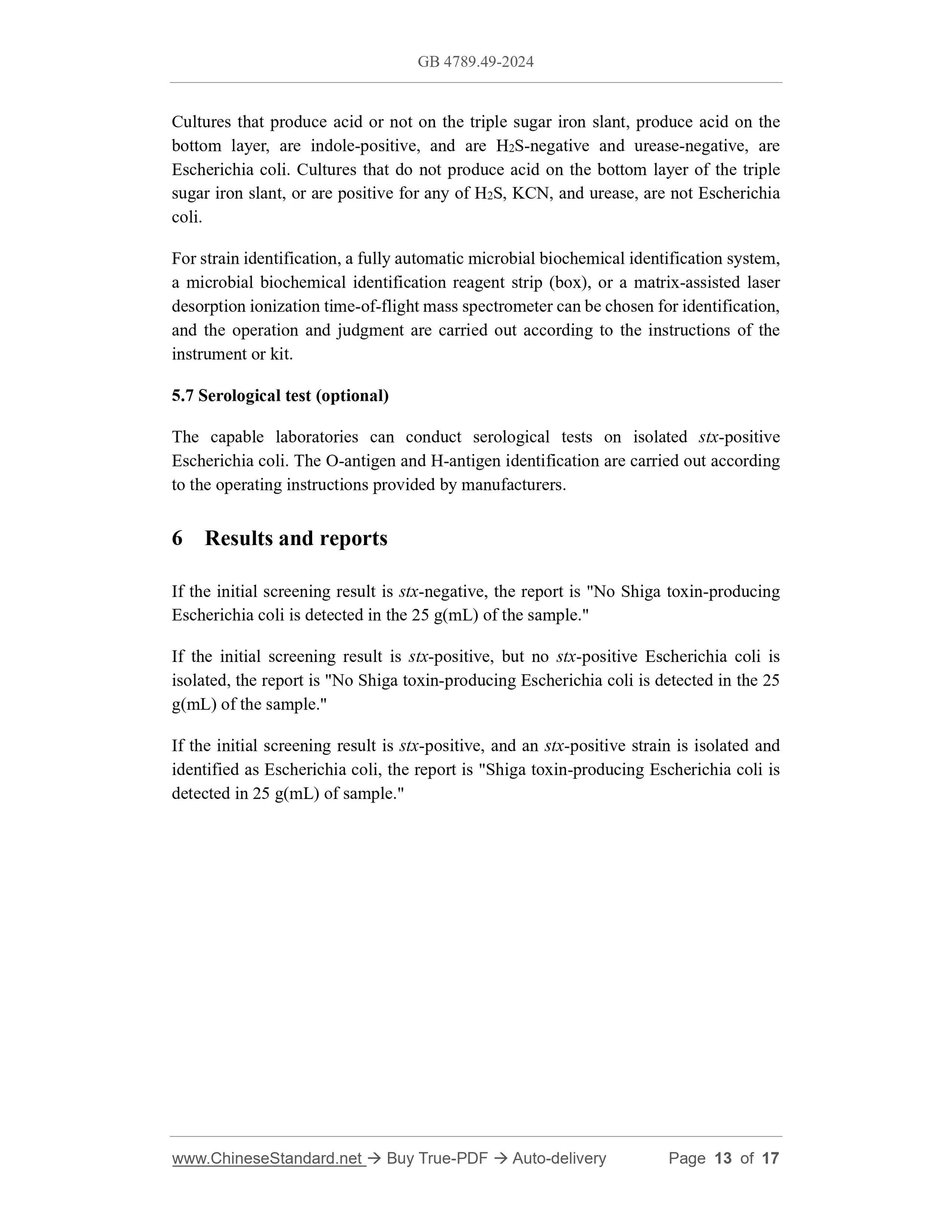1
/
of
8
PayPal, credit cards. Download editable-PDF and invoice in 1 second!
GB 4789.49-2024 English PDF
GB 4789.49-2024 English PDF
Regular price
$215.00 USD
Regular price
Sale price
$215.00 USD
Unit price
/
per
Shipping calculated at checkout.
Couldn't load pickup availability
Delivery: 3 seconds. Download true-PDF + Invoice.
Get QUOTATION in 1-minute: Click GB 4789.49-2024
Historical versions: GB 4789.49-2024
Preview True-PDF (Reload/Scroll if blank)
GB 4789.49-2024: National Food Safety Standards--Food Microbiological Testing--Testing for Shiga toxin-producing Escherichia coli
GB 4789.49-2024
GB
NATIONAL STANDARD OF THE
PEOPLE'S REPUBLIC OF CHINA
National food safety standard - Food microbiology testing -
Shiga toxin-producing Escherichia coli test
ISSUED ON: FEBRUARY 8, 2024
IMPLEMENTED ON: AUGUST 8, 2024
Issued by: National Health Commission of the People's Republic of China;
State Administration for Market Regulation.
Table of Contents
1 Scope ... 3
2 Equipment and materials ... 3
3 Culture media and reagents ... 4
4 Inspection procedures ... 5
5 Operating steps ... 7
6 Results and reports ... 13
Appendix A Culture medium and reagents ... 14
National food safety standard - Food microbiology testing -
Shiga toxin-producing Escherichia coli test
1 Scope
This standard specifies the testing methods for Shiga toxin-producing Escherichia coli
(STEC) in food.
This standard is applicable to the testing for Shiga toxin-producing Escherichia coli in
food.
2 Equipment and materials
In addition to routine sterilization and culture equipment for microbiology laboratories,
other equipment and materials are as follows.
2.1 Constant temperature incubator: 36 ℃±1 ℃, 44 ℃±1 ℃.
2.2 Refrigerator: 2 ℃~5 ℃, -18 ℃~-20 ℃.
2.3 Balance: The sensitivity is 0.001 g.
2.4 Homogenizer.
2.5 Vortex mixer.
2.6 Constant temperature water bath of 50 ℃~55 ℃, and constant temperature metal
bath of 99 ℃±1 ℃.
2.7 Centrifuge: The maximum speed is at least 16000 g.
2.8 Real-time fluorescence quantitative PCR instrument.
2.9 Mixer.
2.10 Sterile pipette: 1 mL (with a scale of 0.01 mL), 10 mL (with a scale of 0.1 mL).
2.11 Electronic pipette or ear bulb.
2.12 Sterile conical flask with stopper: The capacities are 250 mL, 500 mL, and 1000
mL.
2.13 Sterile culture dish: 90 mm in diameter.
2.14 Sterile homogenizing bag: with a filter and a sterile homogenizing cup.
2.15 Flat-cap 8-tube strips or 96-well PCR microplates.
2.16 Magnetic bead separation and enrichment device.
2.17 Micropipette and tip: 0.2 μL~2 μL, 2 μL~20 μL, 20 μL~200 μL, and 100 μL~1000
μL.
2.18 10 μL sterile inoculating loop.
2.19 1.5 mL sterile EP tubes, sterile microcentrifuge tubes, sterile 15 mL centrifuge
tubes.
2.20 0.22 μm pore size sterile filter membrane.
2.21 Fully automatic microbial biochemical identification system.
2.22 Matrix-assisted laser desorption ionization time-of-flight mass spectrometry
(MALDI-TOF MS).
3 Culture media and reagents
3.1 Modified tryptone soya broth medium (mTSB): see A.1.
3.2 EC broth medium (EC): See A.2.
3.3 Tryptone soya agar medium (TSA): See A.3.
3.4 STEC chromogenic medium: see A.4.
3.5 MacConkey agar medium (MAC): See A.5.
3.6 Brain heart infusion broth (BHI)-50% glycerol: see A.6.
3.7 0.85% sterile saline.
3.8 5% Chelex-100 solution: see A.7.
3.9 E-buffer solution: see A.8.
3.10 1 mol/L hydrochloric acid solution.
3.11 1×TE buffer: see A.9.
3.12 Sterile PBS buffer: see A.10.
5 Operating steps
5.1 Sample preparation
5.1.1 Sample storage
After sampling, the sample shall be sent to the laboratory for testing as soon as possible.
If it cannot be tested in time, the sample to be tested shall be stored according to the
sample storage requirements. If there are no special requirements, it shall be refrigerated
in a refrigerator at 2 ℃~5 ℃, and the test shall be completed within 24 hours.
5.1.2 Solid or semi-solid samples
Aseptically weigh and take 25 g of the test sample, add it into a sterile homogenizing
bag with a filter containing 225 mL of EC (or mTSB), and homogenize with a slap
homogenizer for 1 to 2 minutes; or put it into a sterile homogenizing cup containing
225 mL of EC (or mTSB), use a rotating blade homogenizer to homogenize at 8000
r/min~10000 r/min for 1 min~2 min to make a 1:10 homogeneous sample solution.
5.1.3 Liquid samples
Aseptically take 25 mL of the test sample and add it into a sterile homogenizing bag or
sterile conical flask containing 225 mL of EC (or mTSB), and mix thoroughly to make
a 1:10 sample solution.
5.2 Enrichment
Culture the sample solution prepared in 5.1 at 44 ℃±1 ℃ for 18 h~24 h. At the same
time, set up a control test; use the standard strain of Escherichia coli carrying stx1 and/or
stx2 to be cultured in EC (or mTSB) as a positive control, and the standard strain of
Escherichia coli not carrying stx1 and stx2 to be cultured in EC (or mTSB) as a negative
control, and carry out a blank medium control.
5.3 Initial screening of stx virulence genes
5.3.1 Test environment and process control
The environmental conditions and process control of real-time fluorescence
quantitative PCR experiments shall be carried out in accordance with the requirements
specified in GB/T 27403-2008.
5.3.2 DNA template preparation
in fluorescence, and the corresponding Ct values are < 30.
5.3.3.6 Real-time fluorescence quantitative PCR result determination
In compliance with the principle of result validity in 5.3.3.5, when the sample to be
tested is tested,
a) If the Ct values of stx1 and stx2 are ≥40, it is judged as stx-negative;
b) If the Ct value of stx1 or stx2 is < 35, and the Ct value of 16S rDNA gene is
< 35, it is judged as stx-positive;
c) If the Ct values of stx1 and stx2 are both ≥35 and < 40, the real-time
fluorescence quantitative PCR amplification experiment shall be repeated.
After the second amplification experiment, if the Ct value of stx1 or stx2 is
< 40 and the Ct value of the 16S rDNA gene is < 35, it is judged as stx-positive;
if the Ct values of stx1 and stx2 are ≥40, it is judged as stx-negative.
For the sample judged as stx-negative, the result is reported as "No Shiga toxin-
producing Escherichia coli is detected in the 25 g(mL) of the sample" according to the
process.
The sample enrichment solution judged as stx-positive shall be subjected to acid
treatment and immunomagnetic bead enrichment treatment respectively according to
the provisions of 5.4 and 5.5.
5.4 Acid treatment for enrichment solution
Pipette 450 μL of stx-positive sample enrichment solution confirmed in 5.3 into a 1.5
mL sterile EP tube, centrifuge at 10000g for 2 min, discard the supernatant, and
resuspend the bacterial precipitate in 450 μL of E-buffer solution; add 25 μL of 1 mol/L
hydrochloric acid (pH 2.0~2.5), shake at room temperature for 1 hour, streak inoculate
on STEC chromogenic medium or MacConkey agar medium plate with 10 μL sterile
inoculation loop, and culture at 36 ℃±1 ℃ for 18 h~24 h.
Pipette 100 μL of the above acid treatment solution to 900 μL of the E-buffer solution
to dilute it, vortex and mix, then use a 10 μL sterile inoculation loop to inoculate it on
the STEC chromogenic medium or MacConkey agar medium plate, and incubate at
36 ℃±1 ℃ for 18 h~ 24 h.
5.5 Immunomagnetic bead enrichment processing for 7 important serotypes of
STEC
5.5.1 In addition to the acid treatment described in 5.4, the enrichment solution of the
sample judged as stx-positive in 5.3 also needs to be enriched with immunomagnetic
beads at the same time. According to the instructions provided by the manufacturer, 7
important serotypes (O26, O45, O103, O111, O121, O145, O157) STEC are enriched,
and standard strains with corresponding serotypes are set as positive controls. When
there is a deviation between the manufacturer's instructions and the following
description, operate according to the manufacturer's instructions and use one pipette for
each sample to avoid cross-contamination.
5.5.2 Numbe...
Get QUOTATION in 1-minute: Click GB 4789.49-2024
Historical versions: GB 4789.49-2024
Preview True-PDF (Reload/Scroll if blank)
GB 4789.49-2024: National Food Safety Standards--Food Microbiological Testing--Testing for Shiga toxin-producing Escherichia coli
GB 4789.49-2024
GB
NATIONAL STANDARD OF THE
PEOPLE'S REPUBLIC OF CHINA
National food safety standard - Food microbiology testing -
Shiga toxin-producing Escherichia coli test
ISSUED ON: FEBRUARY 8, 2024
IMPLEMENTED ON: AUGUST 8, 2024
Issued by: National Health Commission of the People's Republic of China;
State Administration for Market Regulation.
Table of Contents
1 Scope ... 3
2 Equipment and materials ... 3
3 Culture media and reagents ... 4
4 Inspection procedures ... 5
5 Operating steps ... 7
6 Results and reports ... 13
Appendix A Culture medium and reagents ... 14
National food safety standard - Food microbiology testing -
Shiga toxin-producing Escherichia coli test
1 Scope
This standard specifies the testing methods for Shiga toxin-producing Escherichia coli
(STEC) in food.
This standard is applicable to the testing for Shiga toxin-producing Escherichia coli in
food.
2 Equipment and materials
In addition to routine sterilization and culture equipment for microbiology laboratories,
other equipment and materials are as follows.
2.1 Constant temperature incubator: 36 ℃±1 ℃, 44 ℃±1 ℃.
2.2 Refrigerator: 2 ℃~5 ℃, -18 ℃~-20 ℃.
2.3 Balance: The sensitivity is 0.001 g.
2.4 Homogenizer.
2.5 Vortex mixer.
2.6 Constant temperature water bath of 50 ℃~55 ℃, and constant temperature metal
bath of 99 ℃±1 ℃.
2.7 Centrifuge: The maximum speed is at least 16000 g.
2.8 Real-time fluorescence quantitative PCR instrument.
2.9 Mixer.
2.10 Sterile pipette: 1 mL (with a scale of 0.01 mL), 10 mL (with a scale of 0.1 mL).
2.11 Electronic pipette or ear bulb.
2.12 Sterile conical flask with stopper: The capacities are 250 mL, 500 mL, and 1000
mL.
2.13 Sterile culture dish: 90 mm in diameter.
2.14 Sterile homogenizing bag: with a filter and a sterile homogenizing cup.
2.15 Flat-cap 8-tube strips or 96-well PCR microplates.
2.16 Magnetic bead separation and enrichment device.
2.17 Micropipette and tip: 0.2 μL~2 μL, 2 μL~20 μL, 20 μL~200 μL, and 100 μL~1000
μL.
2.18 10 μL sterile inoculating loop.
2.19 1.5 mL sterile EP tubes, sterile microcentrifuge tubes, sterile 15 mL centrifuge
tubes.
2.20 0.22 μm pore size sterile filter membrane.
2.21 Fully automatic microbial biochemical identification system.
2.22 Matrix-assisted laser desorption ionization time-of-flight mass spectrometry
(MALDI-TOF MS).
3 Culture media and reagents
3.1 Modified tryptone soya broth medium (mTSB): see A.1.
3.2 EC broth medium (EC): See A.2.
3.3 Tryptone soya agar medium (TSA): See A.3.
3.4 STEC chromogenic medium: see A.4.
3.5 MacConkey agar medium (MAC): See A.5.
3.6 Brain heart infusion broth (BHI)-50% glycerol: see A.6.
3.7 0.85% sterile saline.
3.8 5% Chelex-100 solution: see A.7.
3.9 E-buffer solution: see A.8.
3.10 1 mol/L hydrochloric acid solution.
3.11 1×TE buffer: see A.9.
3.12 Sterile PBS buffer: see A.10.
5 Operating steps
5.1 Sample preparation
5.1.1 Sample storage
After sampling, the sample shall be sent to the laboratory for testing as soon as possible.
If it cannot be tested in time, the sample to be tested shall be stored according to the
sample storage requirements. If there are no special requirements, it shall be refrigerated
in a refrigerator at 2 ℃~5 ℃, and the test shall be completed within 24 hours.
5.1.2 Solid or semi-solid samples
Aseptically weigh and take 25 g of the test sample, add it into a sterile homogenizing
bag with a filter containing 225 mL of EC (or mTSB), and homogenize with a slap
homogenizer for 1 to 2 minutes; or put it into a sterile homogenizing cup containing
225 mL of EC (or mTSB), use a rotating blade homogenizer to homogenize at 8000
r/min~10000 r/min for 1 min~2 min to make a 1:10 homogeneous sample solution.
5.1.3 Liquid samples
Aseptically take 25 mL of the test sample and add it into a sterile homogenizing bag or
sterile conical flask containing 225 mL of EC (or mTSB), and mix thoroughly to make
a 1:10 sample solution.
5.2 Enrichment
Culture the sample solution prepared in 5.1 at 44 ℃±1 ℃ for 18 h~24 h. At the same
time, set up a control test; use the standard strain of Escherichia coli carrying stx1 and/or
stx2 to be cultured in EC (or mTSB) as a positive control, and the standard strain of
Escherichia coli not carrying stx1 and stx2 to be cultured in EC (or mTSB) as a negative
control, and carry out a blank medium control.
5.3 Initial screening of stx virulence genes
5.3.1 Test environment and process control
The environmental conditions and process control of real-time fluorescence
quantitative PCR experiments shall be carried out in accordance with the requirements
specified in GB/T 27403-2008.
5.3.2 DNA template preparation
in fluorescence, and the corresponding Ct values are < 30.
5.3.3.6 Real-time fluorescence quantitative PCR result determination
In compliance with the principle of result validity in 5.3.3.5, when the sample to be
tested is tested,
a) If the Ct values of stx1 and stx2 are ≥40, it is judged as stx-negative;
b) If the Ct value of stx1 or stx2 is < 35, and the Ct value of 16S rDNA gene is
< 35, it is judged as stx-positive;
c) If the Ct values of stx1 and stx2 are both ≥35 and < 40, the real-time
fluorescence quantitative PCR amplification experiment shall be repeated.
After the second amplification experiment, if the Ct value of stx1 or stx2 is
< 40 and the Ct value of the 16S rDNA gene is < 35, it is judged as stx-positive;
if the Ct values of stx1 and stx2 are ≥40, it is judged as stx-negative.
For the sample judged as stx-negative, the result is reported as "No Shiga toxin-
producing Escherichia coli is detected in the 25 g(mL) of the sample" according to the
process.
The sample enrichment solution judged as stx-positive shall be subjected to acid
treatment and immunomagnetic bead enrichment treatment respectively according to
the provisions of 5.4 and 5.5.
5.4 Acid treatment for enrichment solution
Pipette 450 μL of stx-positive sample enrichment solution confirmed in 5.3 into a 1.5
mL sterile EP tube, centrifuge at 10000g for 2 min, discard the supernatant, and
resuspend the bacterial precipitate in 450 μL of E-buffer solution; add 25 μL of 1 mol/L
hydrochloric acid (pH 2.0~2.5), shake at room temperature for 1 hour, streak inoculate
on STEC chromogenic medium or MacConkey agar medium plate with 10 μL sterile
inoculation loop, and culture at 36 ℃±1 ℃ for 18 h~24 h.
Pipette 100 μL of the above acid treatment solution to 900 μL of the E-buffer solution
to dilute it, vortex and mix, then use a 10 μL sterile inoculation loop to inoculate it on
the STEC chromogenic medium or MacConkey agar medium plate, and incubate at
36 ℃±1 ℃ for 18 h~ 24 h.
5.5 Immunomagnetic bead enrichment processing for 7 important serotypes of
STEC
5.5.1 In addition to the acid treatment described in 5.4, the enrichment solution of the
sample judged as stx-positive in 5.3 also needs to be enriched with immunomagnetic
beads at the same time. According to the instructions provided by the manufacturer, 7
important serotypes (O26, O45, O103, O111, O121, O145, O157) STEC are enriched,
and standard strains with corresponding serotypes are set as positive controls. When
there is a deviation between the manufacturer's instructions and the following
description, operate according to the manufacturer's instructions and use one pipette for
each sample to avoid cross-contamination.
5.5.2 Numbe...
Share
